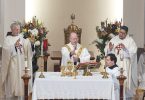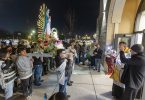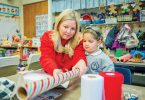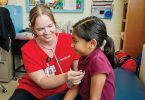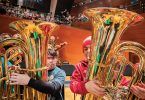
by Therese Horvat
Special to The Leaven
KANSAS CITY, Kan. — Ingenuity, creativity and flexibility were key components of the success of the Catholic schools in the Archdiocese of Kansas City in Kansas this past year.
Add to those, multiple opportunities to teach creatively, fortify faith and build even stronger communities — despite or because of the pandemic — and this school year will be one for the record books.
While other systems and districts offered hybrid or remote learning, archdiocesan Catholic schools opened for in-person classes in fall 2020. Principals, teachers and staff repurposed cafeterias, parish halls and the outdoors to accommodate safe distancing; masks were mandated; and frequent hand-sanitizing occurred.
Technology enabled remote parent/teacher conferences, led to enhanced communications and allowed for streaming of liturgies and fundraisers. Bucking national trends, some schools experienced increased enrollment.
Archdiocesan superintendent of schools Vince Cascone is quick to acknowledge the tremendous dedication of principals, teachers and staff, who focused on doing what was best for students and their families.
Likewise, Lynda Higgins, principal of Resurrection School in Kansas City, Kansas, said the parents have been awesome.
“Everyone pitched in to make this work. It felt like we became a stronger community,” she said.

The students, too, deserve kudos for being problem-solvers and for their compliance with mask and safety regulations out of respect for one another. Pastors, school boards and business teams, the archdiocesan school office and donors received high marks as well for their support and collaboration, as did local health departments.
With state assessments conducted this spring, comparative data on academic achievement is pending. Teachers and principals have worked diligently to minimize pandemic-related learning slides.
In schools where other testing occurred during the year, results appear promising. Janet O’Connell, resource teacher at St. Agnes School, Roeland Park, said that experts agree that in-person learning is generally more effective than virtual for most students.
The backstory
Once schools implemented virtual/online learning in response to last spring’s state-mandated school shutdown, Cascone explained that the conversation shifted to preparations to reopen buildings in fall 2020. At the archdiocesan level, three subcommittees developed recommendations related to academics, health and wellness, and enrollment and finance.
The subcommittees included school leaders, teachers, school counselors, school nurses, physicians and school office representatives. Each subcommittee issued a report with guidance for reopening. Cascone said that utilizing the principle of subsidiarity, the adaptation and implementation of the guidance fell to schools at the local level, and that principals and teachers have done a stellar job.
At St. Agnes, a committee of teachers spent summer 2020 reviewing school procedures and identifying ways to create a safe learning environment. Jane Sullivan, principal, believed this process instilled a sense of ownership. Even simple things —like providing every fourth- through eighth-grader with his or her own storage bin for supplies instead of sharing supplies as they had in the past — was designed for both safety and student independence.
“Before the school year started, each of our teachers made a welcome video to show students their classrooms,” Sullivan said. “Teachers also drove through neighborhoods for driveway visits to meet students and parents and to ease their minds about returning safely to St. Agnes.”
Recognizing that the school would not meet safe spacing requirements based on its existing configuration class sessions, leadership of St. James Academy, Lenexa, added an eighth hour to the schedule and gave each student a study hall period in the dining room. Shane Rapp, principal, said that his team invested considerable time in making this work. Their efforts bolstered the confidence of parents and teachers that St. James was providing a safe environment.
Challenges on different fronts
Finding substitute teachers during the pandemic was one of the biggest challenges schools faced. Eric White, principal of Most Pure Heart of Mary School in Topeka, fortunately had several ancillary staff he could draw from to keep the school operational.

Even with that concern addressed, the school had to begin its Christmas break a week early when multiple support and administrative staff — including White — contracted or were exposed to COVID and required quarantining.
Another challenge was that teachers were responsible for both teaching in-person classes and providing instruction for students who opted for remote learning. Over time, the numbers of remote learners decreased as families chose to return youth to the classrooms.
Still, teachers faced the added pressures of masks, distancing, family health concerns, uncertainties and achieving balance in their lives. Schools sought to sustain teacher and staff morale with relaxed dress codes, professional development by Zoom, treats and ongoing communication. Resurrection School equipped teachers with portable microphones for their classrooms. Father Bill Porter, St. Agnes pastor, closed the school for a day to give teachers a break.
Sports and activities presented other challenges. Most Pure Heart canceled volleyball and basketball earlier in the school year, but offered some sports options this spring. Rapp appreciated the collaboration among archdiocesan Catholic high schools in determining that sports were needed for whole person development of students. He credits Mark Huppe, athletic director at St. James, for working with each coach and athletic trainer at the school to adopt extensive sanitation measures.
At Xavier School in Leavenworth, principal Janelle Hartegan praised the ingenuity of school music teacher Andrea Sladky who introduced gross motor movement and rhythmic activities with tambourines. The school maintained a band throughout the year with dots on the gym floor to mark appropriate distancing.
Creativity abounds
“Our teachers are so creative,” Hartegan enthused. “Given a problem, they’ll figure it out.”
Missing the opportunity to see faces of students and teachers and to exchange relaxed conversation, one teacher asked, “Can we do a picnic?” On a beautiful fall day, students brought beach towels and enjoyed lunch outdoors.
At St. James, when the theater teacher couldn’t locate a socially distanced play for students to perform, the teacher wrote a script for production. Choirs split into smaller groups to facilitate safe practices and performances, and the accompanist started a handbell choir.

Students likewise exercised creativity. When COVID restrictions prevented Sullivan from visiting her mother on her 90th birthday in Nebraska, St. Agnes students leapt into action. They designed greeting cards with messages like: “Don’t worry about your daughter; we’ll keep her safe.” The honoree enjoyed the cards and shared them with friends.
St. James students invited teachers to participate in a morale-boosting rubber duck competition. Teachers paid to participate with the goal of keeping their ducks from being stolen. Half of the proceeds went to charity; half to the winner who donated the funds for a staff happy hour. Rapp found it entertaining to see the lengths to which teachers went to safeguard their ducks.
St. Agnes has produced a weekly Breaking News video with student co-anchors and reporters. The energizing clips showcase school information, the saint of the day, birthday announcements and interviews.
Many schools that transitioned their fundraising events to virtual venues met or exceeded their goals. Michael Morrisey, who with his wife Patty manages the School Advancement Program for the archdiocese, said the response from donors was incredible; he also praised everyone who assisted with these events. Xavier held a successful virtual event that featured videos to recognize four teachers, a silent auction, student performances and live updates as families enjoyed catered meals they had picked up at the school.
Faith foundational; service continues
White believes key lessons of the pandemic are that God didn’t do this to humanity and that people can handle the situation with God’s help. Rapp agreed, saying that the pandemic might actually have helped in the faith arena at St. James.
“We realized that we’re not totally in control,” he said. “We know this is difficult. People are experiencing grief and loss. Our God offers hope. This became a teachable moment for us, and we became more committed than ever to prayer and the sacraments.”
Testifying to this is the fact that daily Mass attendance at St. James is up 50%. In Leavenworth, three area pastors offered weekly Masses in three-month rotations at Xavier, celebrating Masses in the chapel with one class attending and other students viewing in their classrooms. Priests distributed the Eucharist in the hallways.

Schools likewise adapted for service opportunities. Catholic Charities brought projects to St. Agnes School for students to complete. After reading the story “My Librarian is a Camel,” fourth-graders at Xavier asked if they could sponsor a book drive to benefit Children’s Mercy Hospital. Students made posters and promoted the drive to collect new books. The school was hosting a book sale at the time, so parents were encouraged to purchase an extra book for the drive.
“This activity made it feel like we were having a regular school year,” Hartegan recalled.
In the final analysis
“Everybody is so grateful that we stayed open,” White said. “We had a very healthy year with very few students going home sick. Even with all the restrictions, our days remain joy-filled. To date, we have not been thrown a curveball that we couldn’t handle.”
“Our goal was to keep our school day as normal and predictable as possible because everything was so different in the world due to the pandemic,” said Michelle Beaven, Resurrection resource teacher. Joy came from unexpected places.
Beaven recalled an occasion when she was teaching reading skills to first-graders. They lowered their masks briefly to reveal that five of them were missing teeth — something that would have been more obvious in a pre-COVID setting.
Rapp said this year has proven what Catholic schools are capable of.
“It demonstrates the power of Catholic education when parents, teachers and others cooperate to support our mission,” he said. “I told our team that this is the biggest challenge of our professional lives and asked that we make it the finest moment in the life of our school. All our efforts to build relationships and trust came to fruition this year.”
Cascone summed up the year this way:
“With fortitude, flexibility and determination — and under challenging circumstances — we held true to our guiding principles.”

